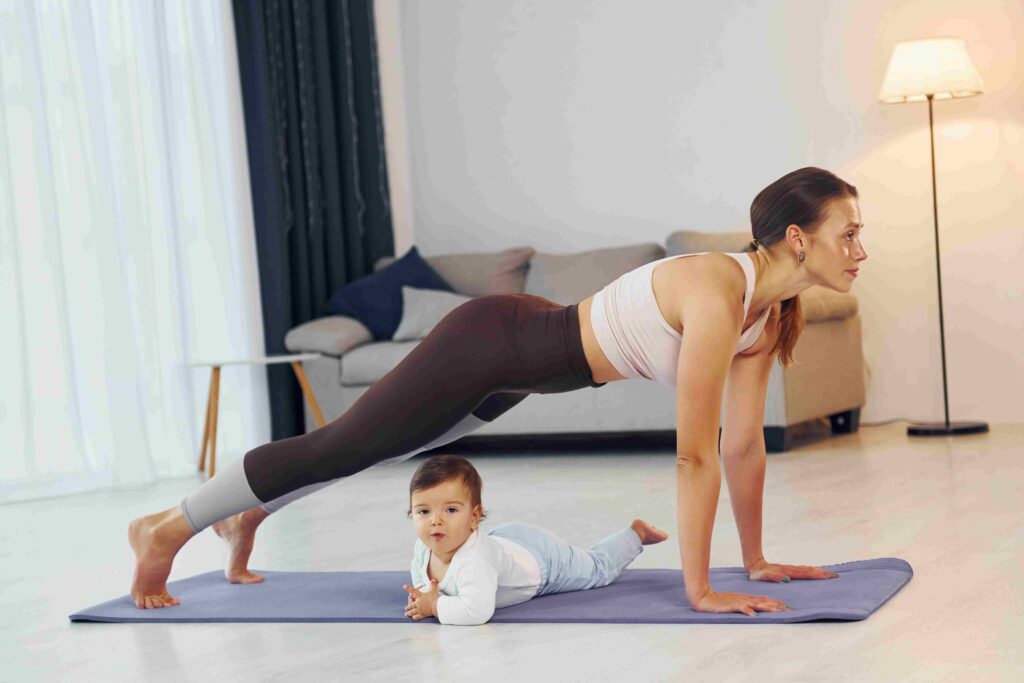- When you can start postpartum abs exercises
- Contraindications for abdominal exercises after childbirth
- Recommendations for Starting Workouts
- Basic Abdominal Exercises
- Additional exercises effective for toning the abdomen
- Exercises with a fitball and with your baby
- Diastasis – A Special Approach to Abdominal Recovery
- Exercises for Diastasis
- What else to do for diastasis
- How to Increase Load Over Time
After childbirth, in the vast majority of cases, a woman’s figure changes significantly. This is especially true for the abdomen, whose muscles become weakened, and the skin stretched and loose. Looking at themselves in the mirror after being discharged from the maternity hospital, many women are immediately determined to return to their pre-pregnancy state and achieve a perfectly flat stomach. This desire is understandable and quite commendable, but new moms should understand that achieving this instantly is unlikely.

When you can start postpartum abs exercises
Achieving the goal of getting your body in shape will take some time if a woman is persistent, eats properly, and exercises her body reasonably. Starting to do abdominal exercises after childbirth without waiting for the body to recover and be ready for active sports exercises can lead to certain health issues for a woman. The duration of the rest period after childbirth — a time without any serious physical exertion — is individual and depends on the method of delivery.
After natural childbirth, one should not engage in active physical training, including abdominal exercises, for about 7 weeks. After a cesarean section, which is essentially a surgical intervention, this period depends on the condition of the scars post-operation, and with normal indicators, the period extends to 12 weeks.

Contraindications for abdominal exercises after childbirth
In some cases, the question of when you can start abdominal exercises after childbirth can only be answered by a doctor after consultation and additional examination. This is especially true when a woman decides to do abdominal exercises with diastasis. The presence of diastasis requires abdominal exercises that differ from the usual ones.
A cesarean section and diagnosed diastasis require consulting a doctor and having them decide whether a woman can begin exercising. Additionally, there are contraindications under which a doctor will definitely prohibit heavy physical exercises and sports activities, including postpartum abdominal exercises.
Such contraindications include the presence of:
- damage to internal organs;
- a scar on the uterus;
- bloody discharge;
- inflammatory diseases of the pelvic organs.
These symptoms make any training and exercises involving abdominal muscles impossible until healing.
Recommendations for Starting Workouts
When striving for a flat stomach, approach it carefully without exhausting yourself with long workouts. Even if a woman has no contraindications, she should perform abdominal exercises according to her fitness level. In the matter of abdominal recovery after childbirth, it is not the number of sets or intensity that matters, but regularity. You should start by mastering the correct technique for abdominal exercises included in the training program. And not immediately, but after preparing the body for loads. Yoga, Pilates, and light cardio workouts are ideal for this purpose.
Breathing exercises that develop the diaphragm can help with this. Such exercises will tone the muscles, making it safer, more effective, and easier to work on abdominal muscles after giving birth. However, attempting to strengthen the abdomen without preparation can lead to weakening of the pelvic floor muscles and prolapse of internal organs.

Basic Abdominal Exercises
After preparing the body for physical activity, you can begin with basic exercises for restoring the abdomen post-birth – “Birch”, “Reverse Bridge”, or “Vacuum”. The first two exercises should be done from the starting position of “lying on your back”. When doing “Birch”, support your thighs with your hands while raising your legs upward, which helps strengthen the lower abdomen. In the “Reverse Bridge”, bend the legs at the knees, lift the hips upward, arch the back, and then slowly return to the starting position.
Initially, the exercise should be repeated 10-15 times per set. Besides the ability to quickly tone the abdomen after childbirth, this exercise also helps tighten the thighs and buttocks. When performing the “Vacuum”, take a deep breath with the stomach, exhale smoothly while pulling it in and out, hold your breath and stay in this position as long as you can hold your breath. Then release the stomach and take a smooth breath. Beginners can do 3-5 repetitions.

Additional exercises effective for toning the abdomen
Home exercises available include the ‘Bicycle’, ‘Plank’, and ‘Lift’. They are simple and effective for quickly restoring abs after childbirth. The ‘Bicycle’ is done by lying on your back and lifting your legs at a 60-degree angle, simulating pedal rotation. The universal exercise ‘Plank’ will strengthen not only the abs but also other muscle groups. It is done by lying on the floor with the body lifted on elbows or straight arms so that it is parallel to the floor.
A less common but effective exercise for restoring a flat stomach after childbirth is the ‘Lift’. Sitting on the floor with your back and shoulders pressed against the wall, place your hands on your stomach and mentally imagine your abdominal muscles as an elevator that needs to be lifted and lowered from the first to the last floor with a straight spine. Then alternately lift the ‘elevator’ from the 1st floor to the 2nd, from the 1st to the 3rd, and so on, while holding the abdominal muscles for 3-5 seconds.

Exercises with a fitball and with your baby
One of the most gentle ways to work on abs after childbirth is through exercises on a fitness ball. They excellently tone the abdominal muscles with minimal strain on the back. One such exercise is performed starting from a lying position on the floor with straight legs resting on the fitness ball. The hips are lifted upwards, rolling the ball back and forth with alternating leg movements. Besides restoring post-childbirth abs, the exercise helps develop the muscles of the chest area and glutes.
You can combine pleasant and useful activities by doing exercises at home with your baby, as the mother not only trains her abs but also spends time with the child, giving attention and bringing positive emotions. The exercise is done standing against a wall with straight legs. One leg is bent at the knee and lifted. The baby needs to be seated on the hip of the extended leg and gently rocked up and down. Then the same should be repeated for the other leg.

Diastasis – A Special Approach to Abdominal Recovery
A special approach to abdominal exercises postpartum is necessary if a woman is diagnosed with postpartum diastasis. This term refers to the separation of the abdominal muscles along the midline. A woman can check for diastasis herself at home. To do this, she needs to lie on the floor, bend her knees, and lift her torso while tensing her abs.
The appearance of a groove between the rectus abdominis muscles during palpation indicates the presence of diastasis. This means that postpartum special exercises for the abdomen will be required, and it will also be necessary to wear a brace. When there is separation of the abs and physical exertion, it will protect the damaged muscles and help them return to their original state more quickly.
Exercises for Diastasis
The restorative exercises for diastasis also differ from those that may be recommended postpartum for women without abdominal separation or by the end of the resting period, it resolved on its own. First and foremost, as already mentioned, it is necessary to consult with a doctor. If they do not object to starting abdominal exercises post-birth, begin the activities. Classical abdominal exercises must be strictly excluded as otherwise, all efforts will lead to an increase in diastasis and, consequently, an increase in the abdomen.
Specialists recommend a unique exercise that can be done sitting, standing, or lying down without being distracted from other tasks:
- draw your stomach in and “reach” your navel towards your spine;
- alternate relaxation and retraction to create quick pulsating movements;
- keep breathing steady, without holding breath.
Such pulsations with the abdominal muscles should be performed no more than 100 times.
What else to do for diastasis
The abdominal muscle tightening and relaxation exercise is effective, but not the only one that can help women who have experienced postpartum abdominal separation return to shape after childbirth. Experts consider the “Cat” exercise to be effective. To perform it, you need to get on all fours, tighten your stomach, and arch your back. Then, on the contrary, you need to tighten your stomach and arch your back towards the floor.
The exercise performed 10-15 times while lying on your back can also help in abdominal recovery from diastasis. On exhale, lift your head off the floor and press your chin to your chest. Your stomach should be drawn in at this time. On inhale, return to the starting position. Lumbar stretching is also recommended, with repetitions of 10-15 times on each side. It’s done by turning your head in one direction and your knees bent in the opposite, holding this position. It’s important to keep your stomach drawn in.

How to Increase Load Over Time
Over time, loads can be gradually increased. To reduce your belly, you need to gradually increase the number of exercises included in your daily at-home workout. When the body has fully recovered and the doctor has no objections to visiting the gym, you can extend the duration of your training. Gradually and carefully, you can make the exercises more challenging by adding elements that make them more difficult to perform.
It’s also worth progressively increasing the number of repetitions of each exercise. For example, starting with a couple of sets, you can gradually increase their number to 5. The intensity of the workouts should also increase simultaneously. A well-rounded approach to increasing physical activity will definitely yield good results and allow you to restore a flat stomach after childbirth relatively quickly.

Our online course offers a program for young mothers focused, among other things, on strengthening abdominal muscles. Ksenia Vlasova, an experienced coach, provides individual consultations for course participants on any questions they may have.
In our online course, our trainers will definitely help you build a proper training system aimed at maintaining women’s health and body tone.


Download the app and get 7 days free use
 eng
eng rus
rus deu
deu spa
spa fra
fra ita
ita por
por srp
srp tur
tur ukr
ukr por
por bos
bos



